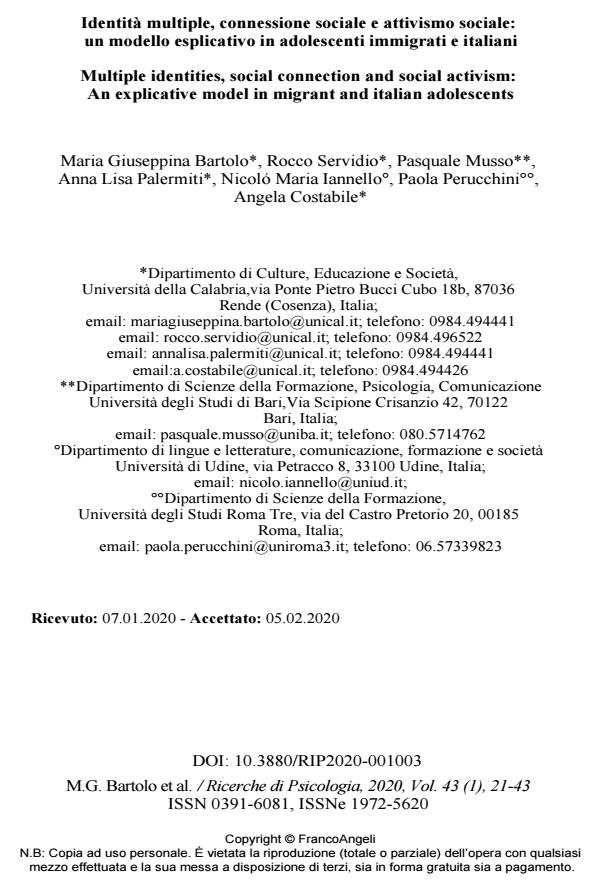Multiple identities, social connection and social activism: An explicative model in migrant and italian adolescents
Journal title RICERCHE DI PSICOLOGIA
Author/s Maria Giuseppina Bartolo, Rocco Servidio, Pasquale Musso, Anna Lisa Palermiti, Nicoló Maria Iannello, Paola Perucchini, Angela Costabile
Publishing Year 2020 Issue 2020/1
Language Italian Pages 23 P. 21-43 File size 273 KB
DOI 10.3280/RIP2020-001003
DOI is like a bar code for intellectual property: to have more infomation
click here
Below, you can see the article first page
If you want to buy this article in PDF format, you can do it, following the instructions to buy download credits

FrancoAngeli is member of Publishers International Linking Association, Inc (PILA), a not-for-profit association which run the CrossRef service enabling links to and from online scholarly content.
Positive Youth Development theoretical perspective posits that youth involvement in actions aiming to promote societal change (i.e. social activism) is a marker of their optimal growth. In particular, it claims that immigrant adolescents’ engagement in initiatives that foster the progress of host communities is a clear evidence of their positive adjustment. From the PYD standpoint, it is necessary to identify individual and ecological factors that boost youth civic engagement. Among them, multiple social identities and connection seem to play a key role, particularly in those ambiguous contexts, such as the Italian one, in terms of immigration policies and inclusion of foreigners in civic participation. On the basis of these premises, the current study tested a model in which multiple social identities positively influence youth social activism through the mediating role of multiple social connection. This model has been hypothesized to be invariant for Italian and immigrant adolescents who grow up in the same, general developmental context, although they experience different life circumstances. Eighty-six immigrant adolescents (57% male; Mage=17.12, DS=1.73) and 114 Italian adolescents (52% male; Mage=16.68, DS=1.68) took part in the research. They were high school students and they were from southern Italy. Self-report questionnaires were administered including three measures of social identity (national, religious, ethnic/regional), three measures of social connection (perceived legitimacy of authorities, connection with Italian society and the religious group) and one measure of social activism. Data analysis provided for the estimation of alternative mediation models (total and partial) and the invariance between immigrant and Italian adolescents. Results suggest that multiple social connection fully mediate the relationship between multiple social identities and social activism in a sort of process that promotes positive civic engagement among both autochthonous and immigrant youths. Findings provide useful insights that might help in the planning of educational interventions that not only incite adolescents to explore they several social identities but also encourage them to feel part of larger communities and to promote societal change in a constructive way.
Keywords: Iimmigrants, PYD, social activism, multiple identities, social connection.
- “I Feel Good, I Am a Part of the Community”: Social Responsibility Values and Prosocial Behaviors during Adolescence, and Their Effects on Well-Being Maria Giuseppina Bartolo, Anna Lisa Palermiti, Rocco Servidio, Angela Costabile, in Sustainability /2023 pp.16207
DOI: 10.3390/su152316207 - Adolescent Psychological Well‐being, Radicalism, and Activism: The Mediating Role of Social Disconnectedness and the Illegitimacy of the Authorities Angela Costabile, Pasquale Musso, Nicolò Maria Iannello, Rocco Servidio, Maria Giuseppina Bartolo, Anna Lisa Palermiti, Rosa Scardigno, in Journal of Research on Adolescence /2021 pp.25
DOI: 10.1111/jora.12590 - In-group and Out-group: Dynamics of the «Russia – West» Social Distance Online and Offline Zinaida Sikevich, Anna Fedorova, in Sociologicheskaja nauka i social'naja praktika /2021 pp.78
DOI: 10.19181/snsp.2021.9.4.8608
Maria Giuseppina Bartolo, Rocco Servidio, Pasquale Musso, Anna Lisa Palermiti, Nicoló Maria Iannello, Paola Perucchini, Angela Costabile, Identità multiple, connessione sociale e attivismo sociale: un modello esplicativo in adolescenti immigrati e italiani in "RICERCHE DI PSICOLOGIA " 1/2020, pp 21-43, DOI: 10.3280/RIP2020-001003